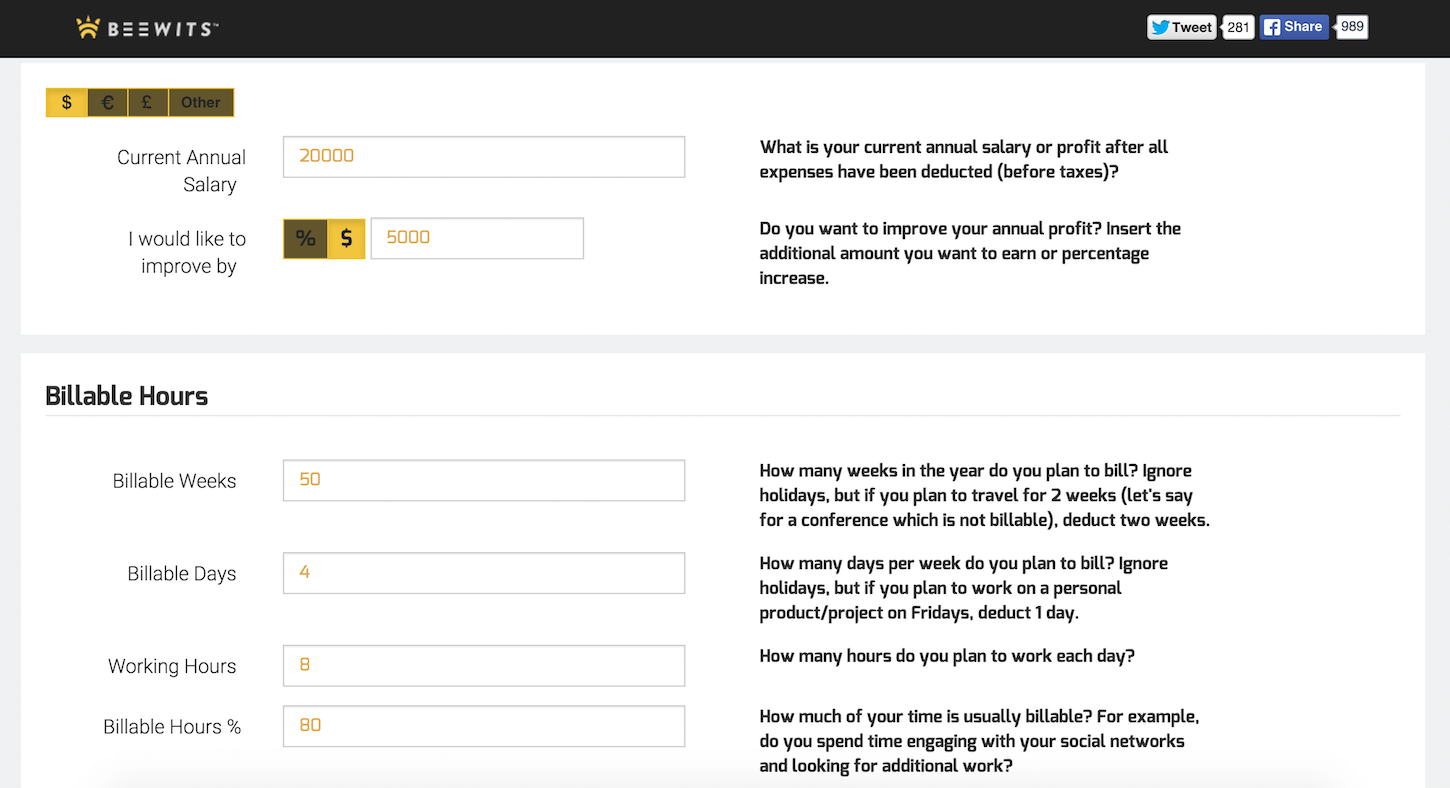Charging the wrong rate can turn your dream of running your own business into a nightmare. But how do you fix the problem once you’ve made that mistake?
One of the biggest decisions we have to make as business owners is how much to charge for services. That will have a profound impact on our success. That’s also one of the first decisions we have to make. A decision that we make with little experience and only a limited frame of reference.
Fortunately, this is not a one-time decision. Increasing your rate over time is possible and in this post, I’ll cover how to calculate a realistic rate and apply that rate to your client-work today.
But let's start with the very real issue of regularly undercharging, and the significant impact it can have on your business.
The consequences of undercharging
In the most extreme cases, undercharging will put you out of business. But most of us don’t make that mistake because we quickly realize the error in our ways.
But undercharging has more insidious consequences. Effects that we feel, but do not necessarily attribute to our rate. Effects we end up just living with, despite the discomfort they create.
For example, do you find yourself working long hours, including weekends and evenings? Do you find yourself unable to take a vacation because you cannot afford to do so? That is a surefire sign that you are not charging enough.
"Do you find yourself working long hours, including weekends and evenings? Do you find yourself unable to take a vacation because you cannot afford to do so? That is a surefire sign that you are not charging enough."
Working long hours also makes it hard to find time for marketing and promoting your business. That makes it difficult to build the reputation that would allow you to charge higher rates.
Then there is the type of client that low rates attract. Do you find that your customers tend to be keen to cut corners to save money? Do they tend to complain a lot or always push for you to deliver more within the same budget? That is an indication that you are operating at the lower end of the market, which is a reflection of charging a low rate.
When working on smaller sites, you might often find yourself working for the business owner instead of a middle manager. These people tend to be much more budget conscious and more demanding in what they want. That often results in lower quality work, which is demoralizing but also can make it harder for you to increase your rates. You get caught in a vicious cycle.
But before we get into how to increase your rates, let's first establish what a realistic price should be.
You might also like: How to Earn Passive Income: The Insider’s Guide.
How to calculate a realistic rate
Many people set their price based on what they think the market can bear. But this is the wrong premise from which to start. Instead, your rate should dictate the market you target, but more on that later.
For now, let's take a look at how you should go about calculating your rate.
1. Establish a minimum take home salary
Your starting point should be the minimum wage you would like to take out of the business. How much do you want to take home over the period of a year? Notice I say the minimum. Don't get greedy, but instead identify the smallest number on which you could live.
2. Add your costs
Next, calculate your various costs. That should include ongoing costs, such as software subscriptions, rent, etc. But it should also include a budget for one-off costs such as new hardware. Once again, work these costs out on an annual basis.
3. Remember to set some money aside
You need to consider the long-term, too. You will need to set aside some money each month for pension and long-term savings. Calculate the total over a year, and add it to your costs and salary.
4. Calculate your tax
The figure you now have will give you an indication of the revenue you must generate before tax. Now, add to that total the tax you would have to pay on that revenue. That will give you the minimum figure you need to earn over the year to create a viable business.
5. Calculate the number of working days
Before we can work out how much to charge per day, we first need to know how many days a year you work. You cannot just divide your target revenue by 365 days, otherwise you will be working every day of the year, and more!
For a start, we need to take off weekends. That reduces the number of chargeable days to 260. Then, we need to consider public holidays. In the UK, where I live, that reduces our chargeable days to 250.
But we still haven't considered vacation time. How much vacation do you wish to take a year? Let's say you settled on 20 days. That reduces the number of chargeable days to only 230.

6. Work out how much of your time is chargeable
Unfortunately, we still cannot take our target revenue and divide it by 230 days. That’s because you will not be able to charge for every hour you work.
There are many other factors to consider. You will spend time marketing, writing proposals, doing admin, and managing your finances. All of these things take time, and yet are not chargeable.
That is the biggest mistake I see people make. They forget to consider these aspects, and so end up doing them in the evenings and on weekends.
Based on my own experience and other business owners I know, in most cases, you can't expect to charge more than 50 to 60 percent of your time. That means the number of chargeable days is going to be nearer 115 per year. That is the number that you need to divide your target revenue by, to give you your minimum daily charge out rate.
But a word of warning. When you calculate that figure, it will probably depress you. You will convince yourself that your clients will never agree to that kind of rate. But they just might, if you approach it in the right way.
"When you calculate that figure, it will probably depress you. You will convince yourself that your clients will never agree to that kind of rate. But they just might, if you approach it in the right way."
How to increase your rates the right way
There are two factors to consider if you are thinking about raising your rates. First, you don't have to do it overnight, and second, you don't have to charge everybody the same price.
Before you implement a new rate, test it out to see whether it’s feasible. Start by only considering a higher rate with new customers. Also, if you’re uncertain, only quote the higher rate with new clients who you wouldn't mind losing. You know, those projects where you’re unsure whether they’re worth pitching for at all.
Once you're a little more confident with the rate, it’s time to roll it out to all new customers. Meanwhile, contact your existing clients and tell them that you have increased your rate, but that because of their loyalty, you will not put up their rate for another six months.
That gives them time to adjust to the new reality, and encourages them to book work with you sooner rather than later.
By experimenting with a higher rate with a few hand-picked new clients, you do not risk damaging your business. That should give you confidence in the new rate for when you decide to broach the subject with your existing customer base. Sure, you will lose some customers. But the higher rate should offset the damage this causes.
However, what do you do if it turns out that even new customers baulk at the higher rate?
How to demand higher rates

Just because the clients that come to you today won’t pay your higher rate, doesn’t mean clients who will don’t exist. There will be customers out there who are willing to pay your higher rate; it’s just a matter of attracting them. In my experience, there are three different ways you can do this.
- Increase your profile. The more well-known you are, the more customers approach you, and the pickier you can be, only accepting the higher value customers. You can do this through writing, speaking, networking, etc.
- Specialize. You can either specialize in a deliverable (e.g. mobile ecommerce solutions) or a sector (e.g. the charity sector). When you have specialist knowledge, people expect to pay a premium.
- Shift to higher paid deliverables. Finally, you may want to shift the type of work you deliver slightly. For example, you get paid less for front-end coding than server side. In my case, I was able to substantially increase my rates when I went from designing sites to offering consultancy services.
Of course, all of this will take time. It’s not going to happen overnight. You will have to gradually increase your rates for new customers, as you adjust your business. By even increasing your rate fractionally it will free up some of those weekends and evenings to start moving your business in a different direction. A path that will allow you to increase your rates further.
Don’t bury your head in the sand
I’m not claiming it will be easy. But what you cannot do is bury your head in the sand. If you undercharge, you will spend the rest of your life working weekends, evenings, and holidays. If you continue doing that, you would be better off getting a job for somebody else.
Read more
- How to Write a Freelance Contract 101
- 13 Best Time Tracking Apps for Designers, Agencies, and Developers
- 3 Project Management Strategies to Prevent Scope Creep
- Designing for Designers: Jen Mussari on her Shopify Partners Mug Design
- 7 Secrets for Balancing Freelance Projects With Your 9 to 5
- 6 Questions to Help You Gauge Client Fit
- Why We’re Sending a Shopify Developer Around the World (And How You Can Connect With Her)
- 9 Noteworthy Coworking Spaces in NYC

